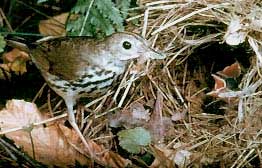 The recent issue of The Auk (subscription or fee required to read full articles) has several articles of interest to state wildlife biologists:
The recent issue of The Auk (subscription or fee required to read full articles) has several articles of interest to state wildlife biologists:
It has long been assumed that early successional forests are important habitat for young ovenbirds. A paper by Andrew Vitz, now with the Massachusetts Division of Fisheries and Wildlife, tested that hypothesis experimentally. He found that the density of understory vegetation was a factor in the birds’ survival, but that the birds could do well in smaller patches of early successional habitat, such as microhabitats within mature forests.
A paper on California spotted owls found that two is the magic number for a number of offspring. Owls that were part of a pair of nestlings had higher survival rates that onlies or triplets. The research also found that the number of young produced is a good indicator of habitat quality.
Read the spotted owl paper here.
Piping plovers hatched earlier in the season in the Great Lakes region had a higher survival rate than those born later in the season, another paper reported. Nest sites that were closer to trees also had lower survival rates. The older the plover chicks were, the more likely they were to live another day. Because the Great Lakes population of piping plovers is federally endangered (with other populations being threatened), these factors can help inform management strategies.
Read the piping plover paper here.
Photo: ovenbird, courtesy Wisconsin Division of Natural Resources
